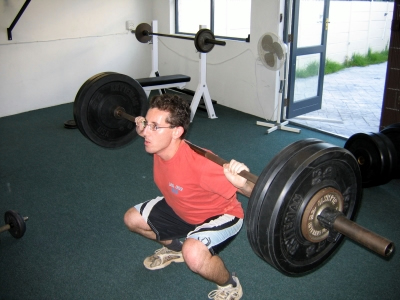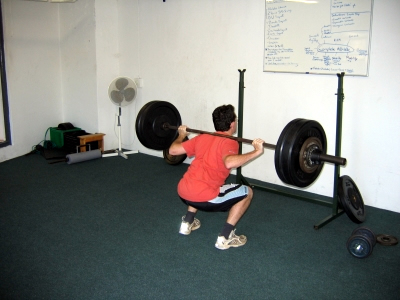The Back Squat for Size and Brute Strength, Part 2
In Part 1 of this article we examined the reasons why we, at Dominate Athletic™, include the back squat in our arsenal of exercises to enhance our athletes’ performance.
Let’s quickly recap these reasons:
1. It is a compound, multi-joint exercise. If you are not convinced why this is an important point, read my article “A Case For Compound”.
2. It is a great way to teach and enhance proper athletic mechanics.
3. It is possibly the most effective exercise in promoting overall muscle mass and developing brute strength.
4. It is a foundational exercise for us, on which we can add other very effective exercises and build an awesome athletic physique.
Alright, so these are just some of the reasons why we employ the back squat in our athletic performance programmes, now let’s have a look at how we perform this exercise.
The Basics of Back Squat Technique:
The back squat is performed with the barbell seated firmly on your upper trapezius muscle, just below your neck. Once you are set, you descend in squat fashion to a place where the top of your thigh is below parallel to the floor. You then stop and ascend back to the start position.

Here are some very important points regarding the performance of the back squat:
1. Take your time: Once you have taken the bar off the Rack, step back a pace or 2. At this point, it would be a mistake to rush into the squatting movement. I always tell my athletes to take their time at this point in order to remember all their checkpoints and really set up properly before squatting.
The set up or “set yourself” command and process is just as, if not more, important than the actual rep. you really need to just step back from the rack and get set without rushing through it and getting the bar back on the rack. This is no time to rush and a rushed back squat can be a very dangerous animal!
(Now for you lifting purists out there or powerlifters please don’t mix a rushed squat with an explosively performed squat – that has to do with squatting tempo and what I am talking about is more of a mindset issue – please do not confuse the two and send me hate mail about how effective a 150kg squat in 2 seconds is – I know, I know!!)
Take your time to focus physically and mentally before dropping into the hole – If dropping is really what you want to do anyway, more on that later!
2. “Set Yourself”: This command is supposed to remind my athletes of the checkpoints of the set up that they need to remember before attempting the rep.
These checkpoints are:
- Head Up: This is an important cue in that it just puts the thoracic and cervical spine into proper alignment for the coming lift. Pick a spot on the wall about standing head height and keep your eyes on that spot throughout the lift.
- Chest Up: This, along with the head up cue, puts the upperback in the correct squatting position.
- Stomach Tight: This checkpoint is here to provide support and intra-abdominal pressure to support the lower back. Our cue is to brace for a punch or really harden your global abdominal muscles (Rectus, Obliques).
3. Your Hips must break 1st: For us this is how we perform the back squat at Dominate Athletic™. We perform the “Powerlifting” squat where we place a lot of emphasis on the posterior chain. How we do this is by initiating the squat with our hips moving backwards first (commonly known as the “Hip-Break” Squat) and then our legs (knees) will do what they need to do on their own (i.e. bend!).
There are many schools of thought with regard to which way of squatting is best for athletic performance – the powerlifting/Hip-Break Squat or the Olympic/Knee-Break Squat. I think there is merit to squatting both ways in order to develop the capacity to perform both movement patterns, but we at Dominate Athletic™ practise the Hip-Break Squat because it is commonly accepted that you can use more weight in this form of squatting [as you are recruiting more of the posterior chain (Hamstrings, Glutes + Lower Back) and therefore using more overall muscle fibres ]. We then perform the front and overhead squats to teach us, and ingrain in our brains, a more athletic and possibly more explosive, movement pattern. And so this is how I see the debate – we squat HEAVY with the Hip-Break Squat and then we get more ATHLETIC with the Front Squat (especially) and also the overhead squat instead of employing the Olympic squat (Knee-Break).
4. Stay Tight: Staying tight throughout the full range of the squat is a very important point – we want our bodies working as one piece and this is the only way of dominating heavy poundages in the squat without incurring injury.
So “Stay Tight” means:
- grip the bar tight. Really squeeze the bar throughout the squat movement.
- pull the elbows forward by flexing the lats hard. Dominate Tip: A way of implementing these 2 first points about staying tight is to try to bend the bar down and forward around your shoulders! Yes, it sounds peculiar but if you really want to maximise total-body tension – Do It!
- keep your head + chest up (Referred to as the “Muscle Beach” Position by 1 of my favourite strength coaches + Authors Dan John). If you perform the above tip, your chest should be up already.
- Keep your stomach tight (braced for a punch).
- and “pull” yourself down into the hole with your hamstrings and glutes instead of just letting gravity drop you.
Then reverse the movement by pressing violently through your feet, while maintaining everything else, all the way to the top.

The Back Squat Lifting Tempo:
With regard to lifting tempo, we at Dominate Athletic™ squat in a 30X or 20X tempo which means we descend in 2 or 3 counts pause at the bottom and then EXPLODE to the top. This way our athletes learn muscular control in the descent (not just falling with gravity) and then we also learn how to explode with the weight on our back. This is our general tempo, there are obviously phases and workouts in our training cycle’s and week’s where we use differing tempos.
Conclusion
I have decided to stop this article here as it seems to have gone on quite long, and I will give you our ways of working the Back Squat into your programme in our next instalment which will be Part 3.
Have a great month and get into the weightroom and start Back Squatting! Do start with very light weights and ask a qualified athletic performance coach to scrutinise your technique before going too heavy or too hard on this awesome and productive , yet not be-all-and-end-all, exercise. Have a great one.
Dig Deep!
Graham Dean.